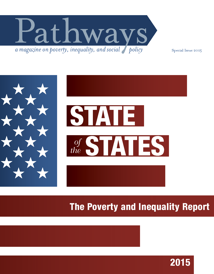Pathways Magazine - Special Issue 2015
A magazine on poverty, inequality, and social policy
Generously supported by The Elfenworks Foundation
- Trends in poverty and inequality: Periodic reports on key poverty and inequality indicators
- Cutting-edge research: Concise summaries of research that is changing how we understand the sources and consequences of poverty and inequality
- Bold new visions: Must-read discussions of how labor market, poverty, and inequality policy might be rethought and changed
- Debates: Leading scholars and policymakers weigh in on the crucial poverty and inequality questions of our time
Click here for the full PDF of the Special Issue 2015.
Click here to subscribe to future issues of Pathways. It's free!
Table of Contents - Special Issue 2015
State of the States: The Poverty and Inequality Report 2015
- Executive Summary
David B. Grusky, Marybeth J. Mattingly, and Charles Varner
States have developed their own constellation of institutions and practices that may in turn result in very different poverty and inequality profiles. But exactly how much difference is observed? Is the United States indeed running 50 very different poverty and inequality regimes? Have any states been able to stem the poverty-increasing effects of the Great Recession? Have any states been able to reverse the country’s spectacular takeoff in income inequality? - Labor Markets
Michael Hout and Erin Cumberworth
The Great Recession spread to every state, though employment fell more in some states than in others. The ongoing increases in the total number of jobs and ongoing declines in the official unemployment rate disguise a very slow recovery in prime-age (25-54) employment. - Poverty
Marybeth J. Mattingly and Charles Varner
The recovery has not translated into a bona fide reduction in poverty (relative to the pre-recession baseline) in any state. In only six states have poverty rates returned to their pre-recession levels. Although blacks and Hispanics face higher risks of poverty in most every state, there is also much state-level variability in the extent of this disadvantage. - Income Inequality
Jonathan Fisher, Jeffrey Thompson, and Timothy Smeeding
There is also increasing cross-state dispersion in the amount of income inequality, with states like California and New York experiencing a 19-percentage-point growth in the share of income held by the top 10%, while states like Delaware and West Virginia experienced only a 9-percentage-point growth. - Spatial Segregation
Daniel T. Lichter, Domenico Parisi, and Michael C. Taquino
There is extreme racial segregation within each of the states; in fact states are, on average, more racially segregated than are cities and metropolitan areas. However, states differ, often dramatically, in the extent to which they are racially or ethnically segregated. For example, 85 percent of blacks in Montana would have to move to a new neighborhood to effect complete integration, whereas only 56 percent of blacks in Nevada would have to do so. - Safety Net
Karen Long Jusko
In non-recessionary periods, the safety net provides about 38 percent of the income support needed to raise incomes up to the official poverty line. Only four states (Massachusetts, New Jersey, Rhode Island, and Washington) provide more than 60 percent of the support needed. - Education
Sean F. Reardon
The size of a state’s racial achievement gaps is strongly related to the extent of racial socioeconomic disparities in the state’s population. States where racial differences in income, educational attainment, poverty, and unemployment are large tend to have the largest racial achievement gaps. Nonetheless, socioeconomic disparities do not fully account for achievement gaps. Unequal access to quality schools likely contributes to the gaps as well. - Health
Sarah A. Burgard and Molly M. King
There is substantial variation across the states in health care access, health behaviors, and self-rated health status. In some southern states, as many as one in five adults report foregoing care even when they need it, a rate twice as high as prevails in many other states. - Economic Mobility
Raj Chetty, Nathaniel Hendren, Patrick Kline, and Emmanuel Saez
There is substantial variation within the United States in the prospects for escaping poverty. In the highest-mobility areas of the United States, mobility rates are higher than rates in most other developed countries, and more than 1 in 10 children with parents in the bottom quintile of the income distribution reach the top quintile by adulthood. In the lowest-mobility areas of the United States, which tend to be in the South, fewer than 1 in 20 poor children reach the top quintile, a rate that is lower than in any developed country for which data have been analyzed to date.
The Stanford Center on Poverty and Inequality is a program of the Institute for Research in the Social Sciences. Funding from the Elfenworks Foundation and the U.S. Department of Health and Human Services (Office of the Assistant Secretary for Planning and Evaluation) is gratefully acknowledged. The research reported here was further supported by the Russell Sage Foundation. The contents are solely the responsibility of the authors and do not necessarily represent the official views of the U.S. Department of Health and Human Services Office of the Assistant Secretary for Planning and Evaluation, Substance Abuse and Mental Health Services Administration, or the Stanford Center on Poverty and Inequality.






